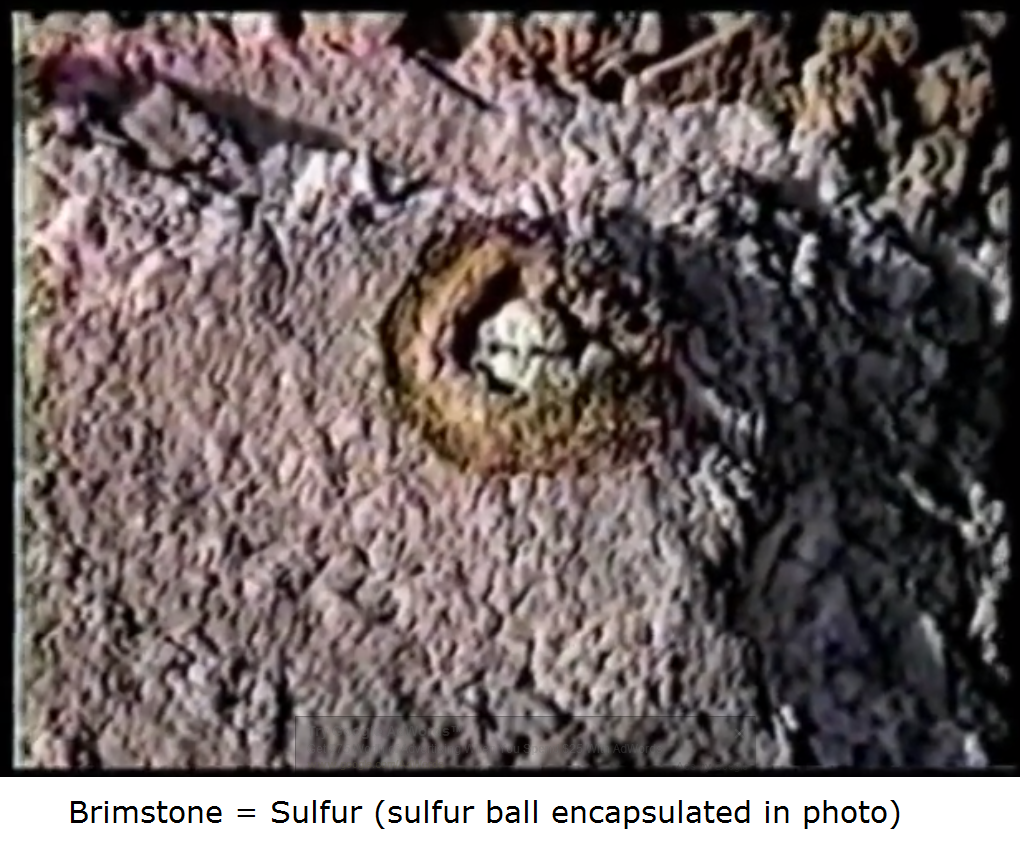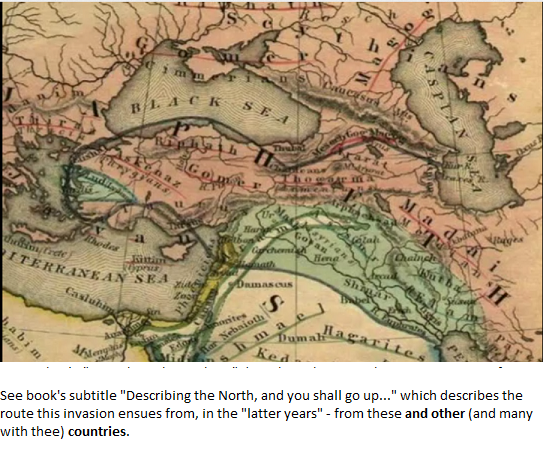T H E A B Y S S
“BOTTOMLESS PIT”
By Lloyd Dale
Thousands, perhaps even millions, of Bible students have read and pondered over the
ominous words “THE BOTTOMLESS PIT” in the several passages shown below: (emphasis and comments added by author)
And the fifth angel sounded, and I saw a star fall from heaven unto the earth: and to him was given the key of the BOTTOMLESS PIT. 2 And he opened the BOTTOMLESS PIT; and there arose a smoke out of the pit, as the smoke of a great furnace; and the sun and the air were darkened by reason of the smoke of the pit. 9:11 And they had a king over them, which is the angel of the BOTTOMLESS
PIT, whose name in the Hebrew tongue is Abaddon, but in the Greek tongue hath his
name Apollyon. (Revelation 9:1)
And when they shall have finished their testimony, the beast that ascends out of the BOTTOMLESS PIT shall make war against them, and shall overcome them, and kill them. (Revelation 11:7)
The beast that you saw was, and is not; and shall ascend out of the BOTTOMLESS PIT, and go into perdition:and they that dwell on the earth shall wonder, whose names were not written in the book of life from the foundation of the world, when they behold the beast that was, and is not, and yet is. (Revelation 17:8)
And I saw an angel come down from heaven, having the key of the BOTTOMLESS PIT and a great chain in his hand. (Revelation 20:1) And cast him into the BOTTOMLESS PIT, and shut him up, and set a seal upon him, that he should deceive the nations no more, till the thousand years should be fulfilled: and after that he must be loosed a little season. (Revelation 20:3)
What is this BOTTOMLESS PIT (abyss or abussos in Greek.)? Where is it located?
Does it have another, possibly more common, name? If so what is that name?
Perhaps many different ideas have been offered to explain this term. We think that there is only one Biblical definition of “the BOTTOMLESS PIT“, and that the Bible itself must supply us with that definition and Yahweh’s Holy Spirit enables us to understand what the apostle John was writing about in Revelation 9, 11, 17 & 20.
The English words “BOTTOMLESS PIT”
are the KJV translations of the Greek words:
abussos
{ab’-us-sos} Strong’s #12 from 1 (as a
negative particle) and a variation of 1037;
TDNT – 1:9,2;
AV
– bottomless pit (5)
– deep (2)
– bottomless (2) [9]
1) the abyss, bottomless pit
2) bottomless, unfathomed: boundless, enormous
3) The rabbinic translation of the Hebrew word t@howm (teh-home’) in the Septuagint.
And:
phrear {freh’-ar} Strong’s
5421 of uncertain derivation; n
AV
– pit (5)
– well (2) [7]
1) a well, the pit or shaft of the abyss
The Hebrew word which is translated abyss, great deep (bottomless) is:
t@howm {teh-home’} or t@hom {teh-home’}
Strong’s 8415 (usually feminine) from 1949; TWOT – 2495a; n
f/m
1) deep, depths, deep places, abyss, the deep, sea
1a) deep (of subterranean waters)
1b) deep, sea, abysses (of sea)
1c) primeval ocean, deep
1d) deep, depth (of river)
2) When the rabbis translated the Hebrew Scriptures into Greek (the Septuagint) they translated the Hebrew word t@howm (teh-home)
into the Greek word abussos.
And a Hebrew word translated pit is:
pachath {pakh’-ath} Strong’s # 06354 probably from an unused root apparently meaning to dig; TWOT 1761a; n m
AV – pit 8, hole 1, snare 1; 10
1) pit, hole
The words and definitions provided above demonstrate that the Hebrew word t@howm is the equivalent of the Greek word variously translated as bottomless or abyss in English. We believe that the word abyss is essentially the English equivalent of the Hebrew t@howm and the Greek abussos.
The Hebrew word t@howm is used many times in the Old Testament.
The most pertinent for our purpose of understanding John’s use of its
Greek equivalent in Revelation is Psalm 36:6:
O Yahweh…thy judgments are an abyss
<08415>: O Yahweh,…
The psalmist, prophet, king David here instructs us that Yahweh’s judgment (justice) is an
abyss. From this we see that the Hebrew prophets used the word t@howm to indicate a place where Yahweh’s judgment (justice) was being applied.
The above words and definitions also establish that the Greek word phrear {freh’-ar} is an equivalent to the Hebrew word pachath {pakh’-ath}. The Hebrew prophets use this word to define the place that Yahweh’s judgment (justice) is being applied. Examples of this can be found in Isaiah 24:17-18; Jeremiah 48:28, & 43-44; and Lamentations 3:47.
Fear, and the pit <06354>, and the snare, are upon
thee (Tyre), O inhabitant of the earth. And it shall come to pass, that he who fleeth from the noise of the fear shall fall into the pit <06354>;
and he that cometh up out of the midst of the pit <06354>
shall be taken in the snare: for the windows from on high are open, and the
foundations of the earth do shake. Isaiah 24:17-18
Fear, and the pit <06354>, and the snare, shall be
upon thee, O inhabitant of Moab, saith the LORD. He that fleeth from the
fear shall fall into the pit <06354>; and he that getteth up out of the pit <06354> shall be taken in the snare: for I will bring upon it, even upon Moab, the year of their visitation, saith the LORD. Jeremiah 48:43-44
Fear and a snare <06354> is come upon us,
desolation and destruction. Lamentations 3:47
John, the Revelator, was also a Hebrew prophet as was Jesus Christ who gave John the Revelation, from this we should understand that John’s use of the words abyss (Gk. abussos) and pit (Gk. phrear {freh’-ar}) would be in the same tradition as other Hebrew prophets.
The Abyss Defined:
By its usage in the New Testament and selected
passages from the Old Testament.
First of all, technically speaking, “abussos, abyssos, abyss” is not an OT term, however, the concept (bottomless) of the Greek word “abussos” exists in the Hebrew word “tehome or tehom.”
The English word abyss is a transliteration of the Greek word “abussos or abyssos” which literally means “without bottom” hence the KJV translation “bottomless” in certain parts of Revelation. In the Greek documents which we call the New Testament, the Greek word or lexeme “abussos” is only used 9 times – 7 times in Revelation and once each in Luke and Romans. To make it easy for everyone, literal translations of these verses are transcribed below:
Luke 8:31 and he (devil) was calling on him (Jesus), that he (Jesus) may not command them to go away to the abyss,
Romans 10:7 or, ‘Who shall go down to the abyss
[of the earth]?’ (that is, to bring Christ out of the dead to bring up
[from the grave].
Revelation 9:1 and the fifth messenger did sound, and I saw a star out of the heaven having fallen o the earth, and there was given to it the key of the pit of the abyss,
Revelation 9:2 and he did open the pit of the abyss, and there came up a smoke out of the pit as smoke of a great furnace, and darkened was the sun and the air, from the smoke of the pit.
Revelation 9:11 and they have over them a king—the messenger of the abyss—a name to him in Hebrew, Abaddon, and in the Greek he has a name, Apollyon.
Revelation 11:7
‘And when they may finish their testimony, the beast that is coming (ascending) up out of the abyss shall make war with them, and overcome them, and kill them,
Revelation 17:8
‘The beast that thou didst see: it was, and it is not; and it is about to come
up out of the abyss, and to go away to destruction, and wonder shall
those dwelling upon the earth, whose names have not been written upon the
scroll of the life from the foundation of the world, beholding the beast that
was, and is not, although it is present.
Revelation 20:1 And I saw a messenger coming down out of the heaven, having the key of the abyss, and a great chain over his hand,
Revelation 20:3 and he cast him to the abyss, and did shut him up, and put a seal upon him, that he may not lead astray the nations any more, till the thousand years may be finished; and after these it behooves him to be loosed a little time.
Now let’s take at each of these.
In context Luke 8, records a conversation that Jesus had with a “devil.” According to verse 29 Jesus commanded the devil to come out a man of Gadarene, then according to verse 28 the devil, apparently speaking through the man, asked of Jesus, “what have I to do with you, torment me not.
Why would the devil think that Jesus might torment him? Could it possibly be that this devil understood that torment was a product or result of the judgment of God? In this context it is clear that the devil is talking about living torment.
Verse 31 records that the devils requested that Jesus “not command them to
go out into the “abyss.” Now in the full context of this passage the “abyss” equates to the torment of judgment (v28); it is used here as a metaphor for judgment and punishment/torment.
In Romans 10:7, Paul uses the word “abyss” as a metaphor for the grave. Paul got this metaphor from Psalm 71:20:
O God, who is like unto thee – who has shown me great and sore troubles – [who] shall quicken me again, and shall bring me up again from the abyss (tehome, S’s #08415 depths) of the earth. (Psalms 71:20)
Thus, Paul used “abyss” as “a metaphor for the grave.” We know this for certain because Paul knew, as we should know, that the body of Jesus was not to see decay (corruption, Psa.16:10 cf. Acts 2:22-32). Death and the grave are the products of God’s judgment upon man as a result of Adam’s sin in the garden.
Before we proceed to examine the 7 places in Revelation where “abyss” is used let us take a look at the Old Testament. In the Hebrew Old Testament, the Hebrew word “tehome” is the equivalent of the Greek word “abussos.” We know this, in part, because the Hebrew rabbis usually translated the Hebrew “tehome” into the Greek “abussos” when they translated the Hebrew Scriptures into the Greek text (Septuagint, LXX.).
This Hebrew word “tehome” is used 36 times in the OT. In the vast majority (33) of those “tehome” is translated “great deep, depths etc. and these are in reference to deep water (oceans, seas, rivers, wells, etc.) as in the following examples:
And the earth was without form, and void; and darkness was upon the face of the deep <tehome, 08415>.
And the Spirit of God moved upon the face of the waters. (Genesis 1:2) In the six hundredth year of Noah’s life, in the second month, the seventeenth day of the month, the same day were all the fountains of the great deep <tehome, 08415> broken up, and the windows of heaven were opened. (Genesis 7:11)
Psalms 104:6 [Yahweh] covered [the foundations of the earth] with the abyss (great deep) <tehome, 08415> as with clothing…
Of these 36 occurrences of tehome (abyss) none of these are a “metaphor for
decay and death.”
The two notable exceptions to this are Psalm 71:20, which is quoted and
applied above, and Psalm 36:6:
Thy (Yahweh’s) righteousness is like the great mountains; thy judgments are an abyss (great deep, tehome <08415>): O LORD, you preserve man and beast. (Psalms 36:6) In this Psalm of David to the chief musician, David sets forth the vices of the wicked and extols the virtues of Yahweh. In verse 6 David compares the righteousness and judgments of Yahweh using two metaphors:
Yahweh’s righteousness is like the great mountains (i.e. expansive and
wondrous) and His judgments are like an abyss (i.e. deep, bottomless, powerful,
etc.)
As Paul went to the Psalms for his metaphor for the grave in Romans 10:7; John, in a similar manner, went to the Psalms for his metaphor for the judgment of God in Revelation 9, 11, 17, and 20.
Now let’s consider those passages. In Revelation 9 John used the lexeme “abussos” 3 times, once each in verses 1, 2 and 11. Chapter 9 is a rendition of the “trumpet”
judgments on the land of Judaea, homeland of the Jews (Judahites). In verse 7 John
wrote, “The first angel sounded [the first trumpet], and there followed hail
and fire mingled with blood, and they were cast upon the land [of Judaea]: and the third part of trees was burned up, and all green grass was burned up.” Then in
verse 13 John wrote, “And I beheld, and heard an angel flying through the midst
of heaven, saying with a loud voice, Woe, woe, woe, to the inhibitors of the
land [of Judaea] by reason of the other voices of the trumpet of the three
angels, which are yet to sound!
Continuing with these trumpet judgments upon the land of Judaea, John wrote, “And the fifth angel sounded, and I saw a star fall from heaven unto the land [of Judaea]:
and to him was given the key of the shaft (pit) of the abyss.”(Rev.9:1) This “star falling from heaven to the land” of Judaea and the presentation of “the key” to this “star” are of very special importance for the people of the land as well as for John’s primary audience of readers in the seven churches of Asia.
John marks this special occasion by switching his terminology from “land” to “abyss” right in the middle of this verse. However, John not only changes his language, he adds a very important new element, “the shaft (pit) of the.” It should be apparent to most readers that the lexeme “land” in verse 1a parallels the term “abyss” in 1b, but what is this “shaft (pit) of the abyss?”
In verse 2 John tells his intended readers that the “star;” identified as “him,” in 1b, used the key and “opened the shaft (pit) of the abyss.” Did you notice that, “the star” opened the shaft (pit) to the abyss; he did not open the abyss. What is this shaft to the abyss?
Moving on to Rev 9:11, John wrote, “And they (the “locusts” of verse 3ff) have a commander (king) over them, the messenger of the abyss, whose name is Abaddon (Hebrew) -Apollyon (Greek) – Destroyer (English). In this verse, as in other apocalyptic Scriptures (cf. Joel 2:25) the “locusts” are the soldiers of invading armies and their commander is the messenger of destruction (judgment) to the abyss (land of Judaea, v1). Therefore, John is using “abyss” as a “metaphor for the land of Judaea in chapter 9.
The next reference to “abyss” by John is in Revelation 11:7: “the beast that comes (ascends) out of the abyss.” Who is this beast that is going to come (ascend) out of the abyss? The answer, of course, is found in Revelation 17:8, which is the next reference to
the “abyss,” where John explicitly states that the, “beast is about to come
(ascend) out of the abyss” and finish the work of destruction that is his destiny. Without going into detail here, this is a living, breathing beast doing the work of destruction. In verse 11 of this same chapter (17) John tells us exactly who this beast is; he is “an eighth king” of the Roman Empire. Thus John uses the lexeme “abyss” as a symbol of the land of Judaea here as well. It is the apocalyptic symbol for the judgment and destruction of Judaea by the armies of the beast and the ten kings (17:12-18:24; and 19:15-21).
I have shown you the true meaning of the lexeme abyss in the New Testament and I can only pray and hope that you have “ears to listen” (Deut.29:4; Matt.11:15; Mark 4:9; Luke
8:8; et al.) and a “mind which has wisdom” (Rev.17:9).
If our reasoning is correct thus far (it is), we now need to look into the New Testament to find out were Yahweh’s (Yahshua’s) justice was to be carried out in the first century and we have the identity (name and location) of John’s abyss.
Our authority for the identity (name and location) of John’s abyss is none other than Jesus Christ:
And when He was come near, he beheld the city (Jerusalem in the land of Judaea),
and wept over it, 42 Saying, If thou hadst known, even thou, at least in this thy day, the things [which belong] unto thy peace! but now they are hid from thine eyes. 43 For the days (of justice) shall come upon thee, that thine enemies (the Roman soldiers) shall cast a trench about thee, and compass thee round, and keep thee in on every side, 44 And shall lay thee even with the ground, and thy children within thee; and they shall not leave in thee one stone upon another; because thou knewest not the time of thy visitation (the day of wrath). (Luke 19:41, comments and emphasis added)
That upon you may come all the righteous blood shed upon the earth, from the blood of righteous Abel unto the blood of Zacharias son of Barachias, whom ye slew between the temple and the altar. 36 Verily I say unto you, All these things shall come upon this generation. 37 O Jerusalem, Jerusalem, [thou] that killest the prophets, and stonest them which are sent unto thee, how often would I have gathered thy children together, even as a hen gathereth her chickens under [her] wings, and ye would not! 38 Behold, your house (of Judah) is left unto you desolate. Matthew 23:35
In the passages quoted above and many others Jesus clearly stated that the just
wrath of Yahweh(Yahshua, Jn.5:22,27,; 8:16 et al.)would be poured out upon the apostate house of Judah in that first century generation. And surely it was, when the
Roman army “stoned” and “burned” the land of Judaea and its capital city Jerusalem in the 3 1/2 year period between 66 and 70 AD.
The apostle Paul concurs with this understanding for he wrote to the first century
Christians:
19 Dearly beloved, avenge not yourselves (upon the synagogue of satan, Rev.2:9; 3:9), but [rather] give place unto (Yahshua’s, Jn.5:22, 27 et al.) wrath: for it is written, Vengeance [is] mine; I will repay, saith the Lord. 13:3 For (Roman) rulers are not a terror to good works, but to the evil (crucifixion of Christ, rejection of His message and persecution of His followers)…: 4 For he (the Roman king, general) is the
minister of God… But if thou do that which is evil, be afraid; for he beareth
not the sword (of wrath) in vain: for he is the minister of God, a revenger to
execute (Yahshua’s) wrath upon him that doeth evil. 5 Wherefore ye must needs be subject, not only for wrath, but also for conscience sake. (Rom. 11:19, & 13:3-5,
comments and emphasis added)
As did the apostle Peter:
1…there shall be false teachers among you, who secretly shall bring in damnable
heresies, even denying the Lord that bought them, and bring upon themselves swift destruction. 2 And many shall follow their pernicious ways;…3…whose judgment, which has been slumbering for a long time lingers no more and their damnation sleeps no more. 9 The Lord knows how…to reserve the unjust unto the day of judgment to be punished: 10. But chiefly them that walk after the flesh in the lust of uncleanness, and despise government.Presumptuous [are they], selfwilled, they are not afraid to speak evil of dignities. 11 Whereas messengers, which
are greater in power and might, bring not railing accusation against them before the Lord. 12 But these, as natural brute beasts, made to be taken and destroyed, speak evil of the things that they understand not; and shall utterly perish in their own corruption; 13 And shall receive the reward of unrighteousness, [as] they that count it pleasure to riot in the day time. Spots [they are] and blemishes, sporting
themselves with their own deceivings while they feast with you; 14 Having eyes full of adultery, and that cannot cease from sin; beguiling unstable souls: an heart they have exercised with covetous practices; cursed children: 15 which have forsaken the right way, and are gone astray, following the way of Balaam [the son] of Bosor, who loved the wages of unrighteousness; 16 But was rebuked for his iniquity: the dumb
ass speaking with man’s voice forbad the madness of the prophet. 17 These are wells without water, clouds that are carried with a tempest; to whom the mist of darkness is reserved for ever. 18 For when they speak great swelling [words] of vanity, they allure through the lusts of the flesh, [through much] wantonness, those that were clean escaped from them who live in error. 19 While they promise them liberty, they themselves are the servants of corruption: for of whom a man is overcome, of the same is he brought in bondage. 20 For if after they have escaped the pollutions of the world through the knowledge of the Lord and Saviour Jesus Christ, they are again entangled therein, and overcome, the latter end is worse with them than the beginning. 21 For it had been better for them not to have known the way of righteousness, than, after they have known [it], to turn from the holy commandment delivered unto them. 22 But it is happened unto them according to the true proverb, The dog [is] turned to his own vomit again; and the sow that was washed to her wallowing in the mire. (2Peter 2:1-3, & 9-22, emphasis added)
War in the Abyss
Therefore, we now understand that John’s abyss of the first century was the land
of Judaea! Now read the following Scripture with the word Judaea inserted in place of John’s cryptic abussos, and we will learn much more about the book of Revelation.
And the fifth angel sounded, and I saw a star fall from heaven unto the land: and to him was given the key of the Judean pit. 2 And he opened the Judean pit; and there arose a smoke (product of Rome’s war with the Jews) out of the pit, as the smoke of a great furnace (the war with the Jews); and the sun and the air were darkened by reason of the smoke of the pit. 3 And there came out of the smoke locusts (men of the war) upon the land: and unto them was given power, as the scorpions (Jewish Zealots) of the land have power. 4 And it was commanded them that they should not hurt the grass of the land, neither any green thing, neither any tree [Ez.17:22-24] (Christians); but only those men (apostate Jews) which have not the seal of God in their foreheads (if they had the seal they would have been Christians). 5 And to them (locusts) it was given that they should not kill them (the Jews), but that they should be tormented five months: and their torment [was] as the torment of a scorpion (i.e. by the zealots), when he striketh a man. 6 And in those days shall menseek death, and shall not find it; and shall desire to die, and death shall flee from them. (read Josephus, The Wars Of The Jews) 7 And
the shapes of the locusts [were] like unto horses prepared unto battle; and on their heads [were] as it were crowns like gold, and their faces [were] as the faces of men (hyperbolic description of the participants in the war). 8 And they had hair as the hair of women (wigs, see Josephus, WOTJ, book IV, ch.IX, Sec.10) and their teeth (swords) were as the teeth of lions. 9 And they had breastplates, as it were breastplates of iron; and the sound of their wings as the sound of chariots of many horses running to battle. 10 And they had tails like unto scorpions, and there were stings in their tails: and their power [was] to hurt men five months. 11 And they had a king over them, [which is] the [angel] messenger of the Judean pit, whose name in the Hebrew tongue [is] Abaddon (destroyer), but in the Greek tongue hath [his] name Apollyon (destroyer, otherwise known as Vespasian-Titus, king (Caesar) of Rome). (Revelation 9:1-11, comments and emphasis added)
In the above passage of Revelation (9:1-11), The “star (that fell) from heaven”
was Vespasian the Roman general that was dispatched from Rome
(“heaven”) by the ruler of Rome, Nero. “The key,” of course was the
authorization to make war against the Jews in Judaea (the “bottomless pit”). When Vespasian “opened” the war against the Jews, the destruction and burning of the cities of Judaea caused a great “smoke out of the pit” or smoke rising up above the land of Judaea. The “locusts (that come) out of the smoke” are the participants of the
war – the soldiers of the Roman army, and the Jewish soldiers; while the “scorpions of the land” are the Jewish Zealots, particularly the tyrant, John Levi of Gischala, and his Zealot army. These latter individuals fought against the Roman army and against their own people, the Jews!
The locusts were commanded by Yahweh to “not hurt the grass of the land, neither
any green thing, neither any tree.” In other words, Yahweh prohibited the Roman Army from hurting any Christians in the land. However, they were permitted
to harm “those men… which (did) not have the seal of Yahweh in their foreheads, but not kill them for five months. The Christians had the seal of God in their forehead, and thus were protected.
While the Romans were not prosecuting the war (five months), the Zealots were
wreaking havoc within the land of Judaea, and the city of Jerusalem.
This was the sting of the “scorpion of the land.”
There is one last item that we would like to mention before moving on to the next
“bottomless pit” passage. Please note that in revelation 9:11 the
king over the soldiers is identified “as the messenger of the bottomless pit.”
Thus, with this new knowledge Revelation 17:3-11 would read as follows:
So he carried me away in the spirit into the wilderness: and I saw a woman
(Jerusalem, the harlot Jer.3:8 et al.) sit upon a scarlet coloured beast (the
Roman empire), full of names of blasphemy, having seven heads (the seven
Caesars) and ten horns (Roman provinces). 17:7 And the angel said unto me,
Wherefore didst thou marvel? I will tell thee the mystery of the woman (Jerusalem, the harlot Ez.23:11 et al.), and of the beast (Roman empire) that carrieth her, which hath the seven heads (seven Caesars) and ten horns (Roman provinces). 8 the beast (Vespasian) that thou sawest was, and is not; and shall ascend out of the Judaean pit, and go unto (the) destruction (of the Harlot, Judaea, Jerusalem, and the temple): and they (the apostate Jews) that dwell on the earth shall wonder, whose names were not written in the book of life from the foundation (beginning) of the world (Mosaic marriage covenant, Ex.17), when they behold the beast (Vespasian) that was (in Judaea), and is not (in Judaea but in Rome to be made emperor), and yet is (emperor, with his army in Judaea). 9 And here [is] the mind which hath wisdom. The seven heads are seven mountains (kingdoms, of the seven kings {Caesars}), on which the woman sitteth. 10 And there are seven kings (the seven
Caesars): five are fallen, and one is (Nero, the 6th Caesar), the other (Galba,
the seventh) is not yet come; and when he cometh, he must continue a short
space (7 months). 11 And the beast (Vespasian) that was, and is not, even he is an eighth, and is of the seven, and goeth unto destruction (sends his son Titus back to Judaea to complete the destruction of Jerusalem). (Revelation 17:3-11, comments and emphasis added)
The last passage in Revelation about the “bottomless pit is Revelation 20:1-10
And I saw an angel come down from heaven, having the key of the Judean pit and a
great chain (the war power) in his hand.2 And he laid hold on the dragon, that old serpent, which is the Devil, and Satan, and bound him a thousand years,
3 And cast him into the Judean pit, and shut him up, and set a seal upon him, that he should deceive the nations no more, till the thousand years should be fulfilled: and after that he must be loosed a little season. 20:7 And when the thousand years are expired, Satan shall be loosed out of his prison, 8 And shall go out to deceive the nations which are in the four quarters of the earth, Gog and Magog (paganism, secular humanism), to gather them together to battle: the number of whom is as the sand of the sea. 9 And they (the adversary’s army) went up on the breadth of the earth, and compassed the camp of the saints about, and the beloved City (Christianity): and fire came down from God out of heaven (the next great event), and devoured them. 10 And the devil that deceived them was cast into the lake of fire and brimstone, where the beast and the false prophet are, and shall be tormented day and night for ever and ever. (Revelation 20:1-3, 7-10, comments and emphasis added)
“The angel that comes down from heaven, having the key of the Bottomless pit” is
Caesar Titus (the title by which Josephus identified the Roman general Titus). In chapter 9 we saw that Vespasian was given the key to the bottomless pit by Yahweh through Nero. Also in Revelation 9:11 Vespasian is identified as “the messenger of
the bottomless pit.” Thus this key was simply transferred to Titus when the new Caesar, Vespasian established Titus as the general or the Roman legions in Judaea,
and ordered his son Titus to prosecute the war with the Jews to the bitter end.
If we are right so far, the “dragon, that old serpent, which is the Devil, and
Satan” which is “bound…a thousand years,” by the angel (messenger of war) of
the bottomless pit (Judaea) is the totally delusional, apostate Zionist Judaism
which is bound (killed, captured and scattered) as the end product of the
war. There in Judaea, this bitter adversary (satan) was “shut up and sealed so that he (satan-the adversary) would “deceive (as national Judaism) the nations no more, until the thousand years are fulfilled:”
The “thousand years” is a symbolic identification for an indefinite period of time (we
think that this is the same period of time which Paul referred to as the time
of “the fulness of the Gentiles, Romans 11:25) that would eventually
be “fulfilled” in the future (from 70 AD). Sometime “after that, he (the adversary [satan]) must be loosed a little season (short time [Gk. chronos], as compared to the indefinite time span of a “thousand years”), and when the thousand years (long time as compared to the “short time”) are expired, satan shall be loosed (released) out of his prison,
and shall go out to deceive the nations…” again.
All the above is verified by the fact that in Revelation 18:23 the Harlot, Jerusalem, is identified as the one that “by thy sorceries were all nations deceived.” In Revelation 12:10c, “the accuser (national Judaism, in the NT Jews are identified as accusers more than 30 times) of our brothers (Christians) is cast down…”
Note that in 20:3 satan (the adversary of Christianity, “synagogue of
satan” Rev.2:9, 3:9) is bound specifically that “he should deceive the nations no more.” And then in verse 8 he ( the Zionist Jew, the great harlot, the deceiver of the nations) is released to “go out and deceive the nations” again!
As the binding aspect of the above did not take place until 70 AD it is totally
impossible that the “thousand years” could be referring to the 40 year period
which began in c. 30 AD and ended in 70 AD, as some insist. The above correlates very well with Romans 16:20 were Paul writes to the Christians at Rome that “Yahweh of peace shall bruise Satan under (their) feet shortly.” What other adversary (satan)
was “bruised” and “bound” shortly after Paul wrote those words?
Ostensibly the “thousand years” ended in 1948 or soon after, when Zionistic Judaism was again established (released) in the land of Judaea. Current world events certainly confirm that the nations are being deceived by something; as it certainly appears that they are being “gather(ed)…together for battle against Christianity (the beloved
city) in general, and the Christian west (the camp of the saints) in
particular. It is extremely interesting that the scenario which John describes
in Revelation 20:7-9a appears to be taking place in the very “world” in which
we are currently living, and Jerusalem, for whatever reason, is right in the
middle. It appears that we may be in for some very “interesting” times as these events continue to play out. It is certainly true that Zionistic Judaism
and Dispensational eschatology have worked “hand in glove” to deceive the
nations during the past 100 years with their false claims that are amazingly
similar given the ostensible diversity of their origins and identities.
In Revelation 20:8-10, John describes a great Gog and Magog army “as numerous as
the sand of the sea” gathered together for war against the “camp of the saints
and the beloved city.” The “beloved city” is an obvious reference to the “new Jerusalem” of Revelation 3:12 & 21-22:5. All understanding Christian Bible students
know that the new Jerusalem is worldwide Christianity. It is our considered opinion that “the camp of the saints” is the Christian west or the United
States of America as between the years of 1620 and 1900
most Christians from the British isles, Europe, and around the world came to
“camp” and establish new homes in American, the “new” land of Christian
freedom.
The “Gog and Magog” army ostensibly could be a reference to all the Islamic nations
and their allies that seem to be gathering for their great “Jihad” (holy war)
against Christians. The Zionist Jews in Palestine and Zionists
Christians (oxymoron) are certainly vigorously stirring this pot.
Although the authors of “the Berean Call” would
vigorously reject the conclusions of this writer as presented herein, they have
unwittingly given complete endorsement to our understanding of these things. In
response to a question from a reader, the February 2002 “Berean Call” gave the
following information:
A reformation of Islam to bring it back to the uncompromising teachings of the Qur’an and to follow faithfully the example of Muhammad…intensifies the oppression that Islam has always exerted over non-Muslims through forced conversions and over Muslims through threat of death for converting to another faith. In fact, an Islamic “reformation” has been in
process for many years. It grew out of the defeat of the Arab
armies that attacked Israel when it declared its independence in
1948, and accelerated with the humiliating defeats of 1967 and 1973. It was decided that Allah had not blessed the Muslim armies as he had at the beginning of Islam because Muslims had strayed so far from orthodox Islam.
Defeat would turn to victory if the Muslim world would return to the
teaching of the Qur’an and of Muhammad in the hadith and…spread Islam through conquest by the sword…
The Islamic “reformation…” (produces) an
Islam that is stronger and absolutely uncompromising. It involves a revived commitment to the teaching that Muslims must conquer the world and impose their religion and way of life upon all mankind to the glory of Allah…A return to true Islam as taught in the Qur’an demands perpetual jihad with the sword… (emphasis added)
Another futurist, Zola Levitt; who would also vigorously reject the positions stated
herein nevertheless recognized the international importance of Islamic
terrorism as follows:
The cataclysmic increase in (Islamic) terrorist acts last year
(2001) was a turning point in history one that will… eventually (affect) the
entire world. (Zola Levitt letter February, 2002, emphasis added)
When the time for these events reach their fullness, John writes that, “fire came
down from heaven and devoured them (the Gog and Magog army). And the devil that deceived them was cast into the lake of fire and brimstone…”
In other words this devil, Zionism, is caught right in the middle of
this “holy war” and is destroyed along with all the other enemies of Christianity.
SUMMARY
We think that the information provided above gives us a very realistic look at
some highly symbolic passages of Scripture. It establishes that the “BOTTOMLESS PIT” was the land of Judaea, which included Galilee, Jerusalem,
the apostate Jews and the temple. Yahweh-Yahshua’s judgment-justice or vengeance is being poured out within and upon this abyss by the Roman Army.
This is confirmed by the description of this war written by John in
Revelation17:11-17:
11 And the beast that was, and is not, even he is the eighth, and is of the seven, and goes unto [the] destruction (of Jerusalem). 12 And the ten horns which thou sawest are ten kings, which have received no kingdom as yet; but receive power as kings one hour with the beast. 13 These have one mind, and shall give their power and strength unto the beast. 14 ¶ These, with the Lamb shall make war(against the whore), and the Lamb shall overcome her (the whore, vs.3-6, 16 & 18): for He is Lord of lords, and King of kings: and they that are with Him are called, and chosen, and faithful.
15 And he saith unto me, The waters which you saw, where the whore sit, are peoples, and multitudes, and nations, and tongues. 16 And the ten horns which you saw upon the beast, these shall hate the whore, and shall make her desolate and naked, and shall eat her flesh, and burn her with fire (for the Lamb). 17 For God has put in their hearts to fulfil his will, and to agree, and give their kingdom unto the beast, until the words of Yahweh shall be fulfilled (i.e. until the whore [Jerusalem] is destroyed). 18 And the woman which thou sawest is that great city (Jerusalem), which reigns over the kings of the earth. (Revelation 17:11-17, Emphasis and comments added)
Because of the faulty KJV (and most others) translation of this verse shown below, Christians have generally misunderstood and misapplied this verse:
14 ¶ These shall make war with the Lamb, and the Lamb shall overcome them: for he is Lord of lords, and King of kings: and they that are with him are called, and chosen, and faithful. (Revelation 17:14 KJV)
Compare the KJV translation with the translation given above. There is a vast difference. Based upon the KJV translation, Christians have believed that “the Lamb” made war (as in the NASV) against (with, KJV) the beast’s army and
defeated them (the beast and his army).
However, study the context. The context is clearly about the war that is to be waged against the whore to destroy her (vs.3-6, 16-18), not about a war against the beast and his army! That verse as translated by the KJV and most others is completely out of character and context.
As shown above, in context, the verse
is properly translated:
These, with the Lamb shall make war, and the Lamb shall overcome her (the whore, vs.3-6, 16 & 18): for he is Lord of lords, and King of kings: and they that are with Him are called, and chosen, and faithful.
According to the full context of these things; the Lamb uses the Roman army to bring His
avenging judgment (Rom.12:19 & 13:1-4, et al.) upon the whorish city of Jerusalem,
the apostate Jews and the temple that they abominated.
The Roman king (Caesar) that is described so cryptically as the one who “was
(with Nero), and is not (on the throne); and shall ascend (to the throne of Rome) out of the BOTTOMLESS PIT (Judaea), and go (continue?) unto (the) destruction (of Jerusalem)
is Vespasian, with his son Titus, who had been dispatched by Nero to Judaea with the Roman army to squelch the Jewish revolt. They had captured many of the
cities of the land and were about to lay siege to Jerusalem when word reached them that Nero had died by the sword. They immediately put the war into abeyance until a new Caesar had been established. After much discussion and persuasion, the army
eventually anointed Vespasian king (Caesar) of Rome, He acquired the support of
Alexander of Egypt and others then he went to Rome to be officially crowned
king (the eighth Caesar of Rev.17:11). Thus John describes him as “an eighth, and is of the seven” because he was not of the family bloodline of the Roman Julius Caesar but he
would be the eighth Caesar and thus “of the seven” (because of his
service with Nero) as the eighth Caesar of the Roman Empire.
There is a very interesting comment in Josephus about an “sacred oracle” that
ostensibly applies to this Revelation passage.
Josephus states:
But now, what did most elevate them in undertaking this war was an ambiguous oracle (Rev.17:10-11) that was also found in their
sacred writings, how, “about that time, one from their own country (this shows that the Jews understood John’s bottomless pit to be “their own land”) should become governor (Caesar) of the habitable earth (Roman empire).” The (apostate) Jews took this prediction to belong to themselves in particular; and many wise men were thereby deceived in
their determination. Now this oracle certainly denoted the government of
Vespasian, who was appointed emperor in Judea. (WOTJ Book VI,
ch.V, Sec.4, emphasis and comment added)
According to Josephus, The Roman army wanted Vespasian to become emperor because of his age, excellent character, experience and military record. They also considered Vespasian and his son Titus as the “dynamic duo” that would be able to salvage the Roman Empire with Vespasian as king and his son Titus leading the army. When Vespasian went to Rome to officially begin his reign, Titus returned to Judaea to continue the prosecution of the war against the Jews and was “sent (by Vespasian) to destroy Jerusalem” which he eventually did. In his writings, Josephus often refers to Titus as “Caesar” even while Vespasian was the ruling monarch. (Wars Of The Jews, Book III, ch. 1, sec.3 p.502 – ch. 10, P.546)
Once we understand the proper relationship between Nero, the sixth king and
Vespasian “an eighth”, we are in a position to see more clearly the meaning of
certain parts of Revelation 13:
And I saw one of his headsas it were wounded to death; and his deadly wound was healed: and all the land wondered after the beast…and they worshipped the beast, saying who is able to make war with him? …he that
kills with the sword must be killed with the sword. (Rev.13:3, 4b, & 10b, emphasis added)
In Revelation 13, John vividly describes an incredible “beast” which is the Roman Empire.
However he also states that the “beast” has seven heads. These seven heads are “house of Caesar” (Julius, Augustus, Tiberius, Caligula, Claudius, Nero, and Galba). At
the time that the Revelation was first put into circulation five of those
“heads” had died and the sixth one (Nero) was currently reigning. John tells his first century readers that the sixth “head” would die by the sword [vs.10b] and that at his death by the “deadly wound” [vs.3] the “beast” (Roman Empire) would be thrown into a great turmoil. During this turmoil the “seventh head” (Galba) would come to power, but he
would only last a “short time” (7 months & 7 days, Rev.12:10). Also, out of the turmoil stemming from Nero’s corrupt and violent reign, and his unexpected death by the sword (Rev.13:10) and the ensuing fight for the control of the Roman Empire (the beast), it would appear that the “beast” (Roman empire) itself was about to self destruct (Rev.13:3). However,
during this great period of turmoil “an eighth” head would come forth (“ascend
out of ,” Rev.17:8) from the abyss (Judaea) and restore the fortunes and power of the Roman Empire (“beast”). “An eighth, and is of the
seven” because while the sixth head (Nero) reigned, the one who would be “an eighth” was Nero’s top general carrying out his assignment to squelch the rebellion in Judaea, however, he was not of the “house of Julius Caesar” so he “was of
the seven” but not from the same family line, therefore, he was an eighth king
(Caesar) of the Roman empire but he was also the first of a new line of Caesars
(Vespasian, Titus, and Domitian) who would reign for the rest of the first century
and beyond. Therefore, Vespasian “was” (in Judaea as a representative of the sixth head), and “is not” (Caesar while the Empire was in turmoil after Nero’s death),
but would “ascend out of the abyss” (go out of Judaea) to become the “head/king”
(Caesar) during the “destruction” [Rev.17:8] of Jerusalem, the temple, and the apostate house of Judah in 70 AD.
For Additional information on Bible history and prophecy contact:
Lloyd Dale, Founder and CEO
Olive Tree Ministries
19463 US Hwy 12
Lemmon, SD 57638
Phone: 1-605-374-3291
BOOK 1 ~ THE LAST DAYS EDITION
(available in 3 formats)








